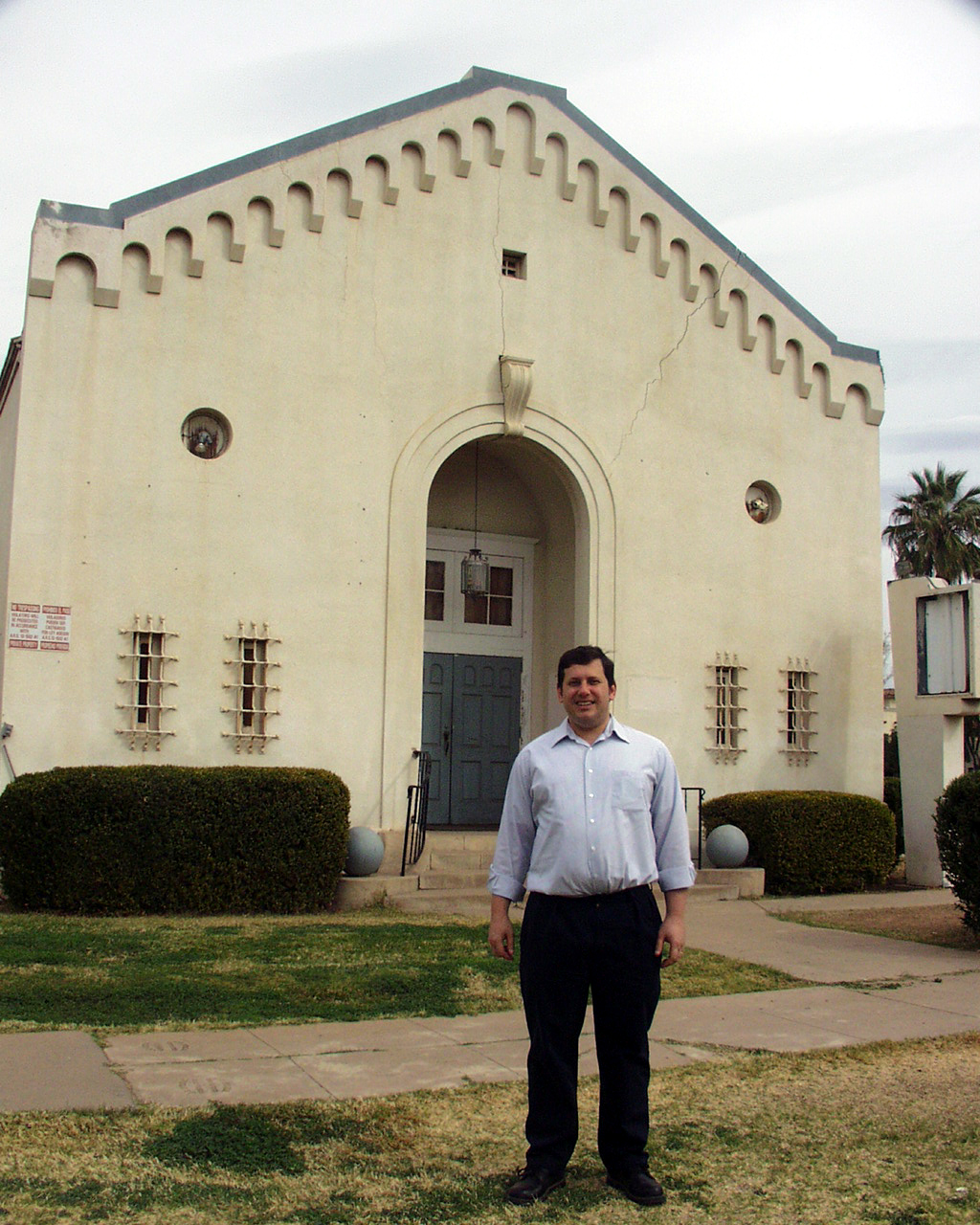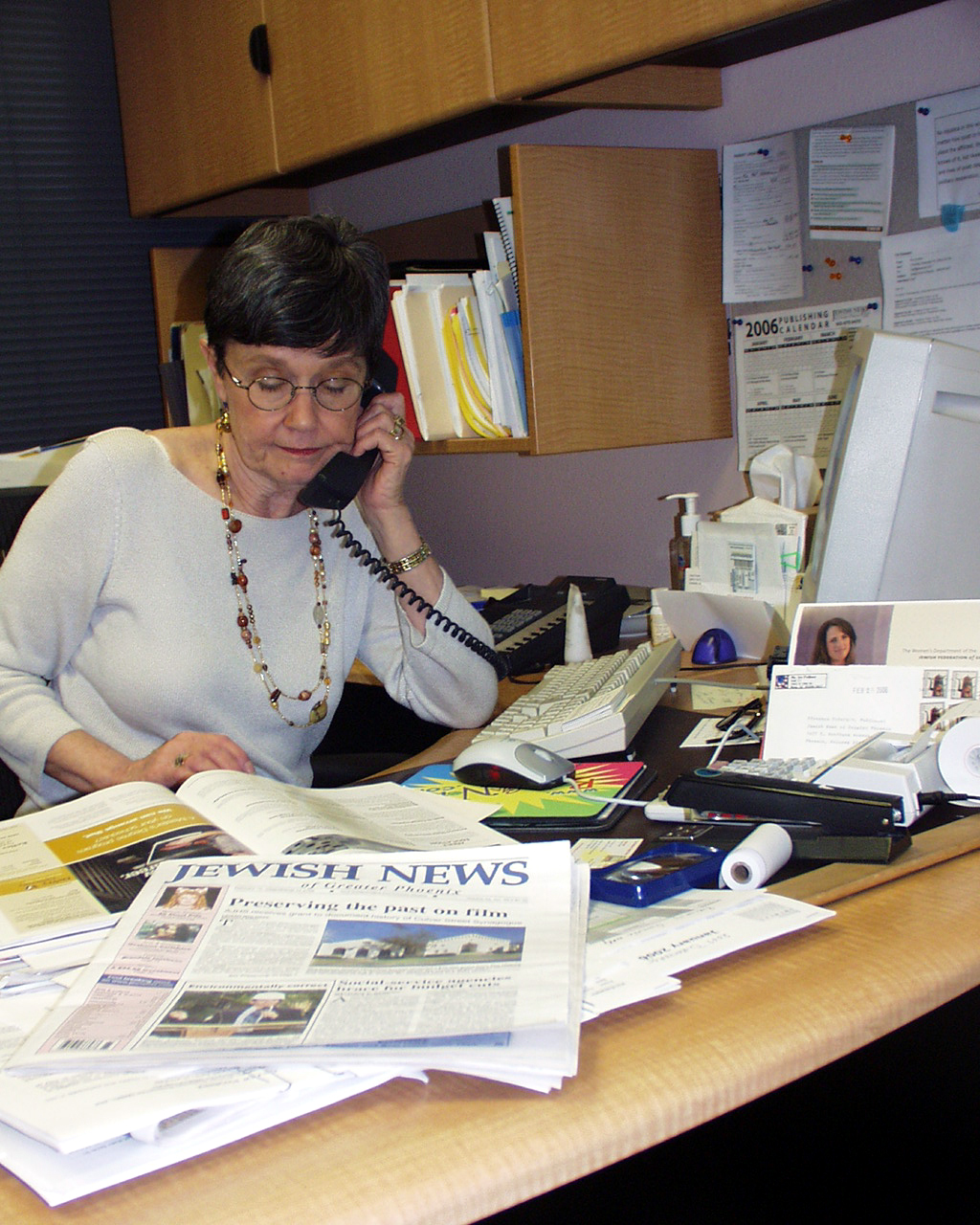|
By Donald H. Harrison
PHOENIX, Ariz.— Lawrence Bell, executive director of the Arizona Jewish
Historical Society, observes, "We can educate non-Jews about Jewish history
and Jewish heritage or you can let Mel Gibson do it. But, somebody
is going to educate non-Jews about us, and they are going to form ideas about
us, so why not be an active part of that process?"
The Arizona Jewish Historical Society recently acquired the downtown building
which served as Phoenix's first synagogue. The society now is engaged in a
multi-million dollar fundraising campaign to turn it into a museum, events
center and archive. The nearly one-acre site now known as the Cutler-Plotkin
Jewish Heritage Center is adjacent to the main branch of the Phoenix Public
Library and is within the area that the city government wants to promote as an
arts and cultural district.
Bell anticipates that most visitors to the center will be Gentiles, particularly
school children who may tour the facility as part of their multi-cultural
learning programs. Within a short distance of the center is the famed Heard
Museum, which specializes in Native American heritage. An Irish cultural center,
a Chinese cultural center and a Japanese friendship garden are within short
drives away.
The Cutler-Plotkin Jewish Heritage Center's mission will be "to educate
Jews and non-Jews about the substance of our history, our religion, our culture,
our heritage, and the ways that Jews have contributed to the state and to the
country," Bell said.
"I don't think there are too many Jewish institutions in our community at
least, and probably in any other, that do that work specifically. I think
that Jews do a lot of work to educate Jews about Jewish heritage, but I don't
think as much attention is paid to the general population."
Built in 1922 as Temple Beth Israel, at a time when there were only 120 known
Jews in Phoenix, the building served the community until 1949, when it was sold
to the Southern Baptist Convention. For the next 34 years, it served as
the First Chinese Baptist Church, and then in 1983 it became the Central Mexican
Baptist Church. "It housed two religions and three ethnic groups"
before its recent reacquisition by the Jewish community, Bell
commented.
 
Lawrence Bell, Ph.D, executive director of the Arizona
Jewish Historical Society, stands in front of the main
building of a nearly one-acre complex that will become a center to explain
Jewish history and culture to non-Jews,
particularly to school children. At right is Flo Eckstein, publisher of
the Jewish News of Greater Phoenix,
whose parents came to Phoenix during the 1920s.
Temple Beth Israel long since has moved farther
north—following the Jewish demographic trend in Phoenix—but during the
27 years that it occupied the site near today's 7th Street exit on
Interstate-10, the building served both as a synagogue and activities center for
the community.
The sanctuary probably will be used for exhibits about Jewish holidays and
Jewish life cycle events, as well as for some explanatory information about the
Jewish religion. Remodeling will remove the baptismal font and restore the
recessed aron kodesh, the outlines of which can still be discerned
through the wall plaster.
On the other hand, wooden pews that were added during the
Baptist periods of the building will remain in the sanctuary, in order to
provide event seating, Bell said. While the Cutler-Plotkin Jewish
Heritage Center will cover the basics of Jewish observance, it is not intended
to be a museum of Jewish religious artifacts. That function, says Bell, already
is being fulfilled handsomely by the Sylvia Plotkin Judaica Museum, located at Temple
Beth Israel's current site at 56th and Shea in northern Phoenix.
The Sylvia Plotkin Judaica Museum, which counts among its exhibits a reconstruction of
a small Tunisian synagogue, was named after the late
wife of longtime Reform Rabbi Albert Plotkin, who assumed his pulpit in the
1950s and remains a major force in the Jewish community's development. The
Cutler-Plotkin Jewish Heritage Center was named by donor Larry Cutler both in
the revered rabbi's honor and in memory of Cutler's parents, Betty and James,
who were killed in an automobile accident.
Arizona Jewish history will be the focus in a 1936 classroom and office annex
building. Visitors will be able to flow through a series of rooms
featuring exhibits on the history of the Jewish communities of Arizona,
generally, and Phoenix specifically.
Bell said because the area for these permanent exhibits is small, he hopes to be
able to utilize television monitors and listening areas to increase the number
of stories that can be told. The Arizona Jewish Historical Society to date
has completed approximately 200 oral histories, some of which in digitalized
form potentially could be incorporated into the exhibits.
Pearl Newmark, who arrived in Phoenix in 1926—only 14 years after Arizona
became a state—is among the early settlers whose memories the museum has been
tapping. Newmark and her late husband, Cecil, published the Jewish News
of Greater Phoenix from 1961 to 1981, before selling the publication to
their daughter, Flo Eckstein, the current publisher. The same year that Eckstein
took over, the Arizona Jewish Historical Society began. The new publisher,
her attorney husband Paul, and parents all became charter members.
As interviewee, rather than in her more accustomed role as interviewer,
Eckstein told jewishsightseeing.com that when she was born in 1940, there were
fewer than 2,000 Jews in Phoenix, with the overall population of the area being
60,000. Today, the community counts approximately 100,000 people living in
Jewish households (including some non-Jewish spouses) and the overall population
of Maricopa County, including Phoenix and its suburbs, is 3 million.
Eckstein said many people including her
Pennsylvanian parents came to Phoenix for health reasons. The military brought
numerous armed forces personnel to Phoenix area bases during World War II,
resulting in many of them deciding to come back following the war. Among
the installations was a camp for German Prisoners of War at Papago Park.
"If I recall, when I was a little kid, there was one Reform congregation,
Temple Beth Israel, and the Conservative congregation was Beth El. Then at
some point, two Orthodox congregations opened up, neither of which exists
anymore," she said. Orthodoxy has resurged more recently,
particularly with the proliferation of Chabad centers.
Movie producer and director Steven Spielberg was among the youngsters who
studied for a bar mitzvah ceremony at one of those original Orthodox
congregations, Beth Hebrew.
A Jewish Community Center was founded in Phoenix in the late 1940s, and
"there was the Jewish Community Council, which became the Federation. My
mother was the first president of the local Hadassah, in 1940, but then she was
pregnant with me, so she resigned." Eckstein
said. The daughter later made up for depriving the organization of her
mother's services by herself becoming a life member of the organization.
Prior to taking over as publisher of the newspaper, Eckstein worked for Jewish
Family and Children's Service, where she focused on the resettlement of
Russian Jews. Today, a significant number of Bukharin Jews from the
Central Asian portion of the former Soviet Union are part of the Phoenix
community, the publisher noted.
The stories of the Newmarks, Ecksteins, Beth
Hebrew congregants, Bukharian Jews and many more have and will be collected
in the Archive of the Arizona Jewish Historical Society. The
organization already boasts a collection of more than 20,000 books and
manuscripts.
The Archive will share space with temporary exhibits, such as those
currently traveling from city to city like the replica of the Anne
Frank House, behind the sanctuary in a large building that the Chinese Baptist
Church had constructed for offices and a social hall.
The Arizona Jewish Historical Society currently works in cramped office
building quarters at 4710 N. 16th Street. Once the society relocates
to the remodeled Jewish Heritage Center, it will have considerably more
room to display some of its treasures, including more than 1,000 historic photos
recently acquired from the Jewish Federation of Greater Phoenix. The
photos document communal activities from 1948 to 1987.
Bell said he anticipates that there will be numerous
opportunities for cooperative arrangements with other Phoenix cultural
institutions, starting with the Public Library. He
said hopes the library will be willing to handle check out of books from
the Archive, in exchange for the American Jewish Historical Society making the
large collection available to the general public.
Besides in the sanctuary and the old social hall, the Cutler-Plotkin
Jewish Heritgage Center will stage receptions and other events in a large
open-area corner of the property. Arizona's desert weather almost always
cooperates with outdoor events, Bell said.
It cost more than $500,000 to acquire the old synagogue and surrounding
structures, and now Bell reports the Arizona Historical Society is about a third
of the way toward raising the $4 million needed for restoration, financing and
endowment for the 13,000 square foot facility.
By phasing the reconstruction, Bell said, it is possible that some work
on the non-historic buildings can be completed in 2007.
Meanwhile, says Bell, some small Depression era residences that are on the
opposite side of the parcel from the open air reception area are being
offered for free to anyone interested in moving them. Historical museums, like
every other building attracting visitors, require on-site parking, so the old
houses must be moved.
|

